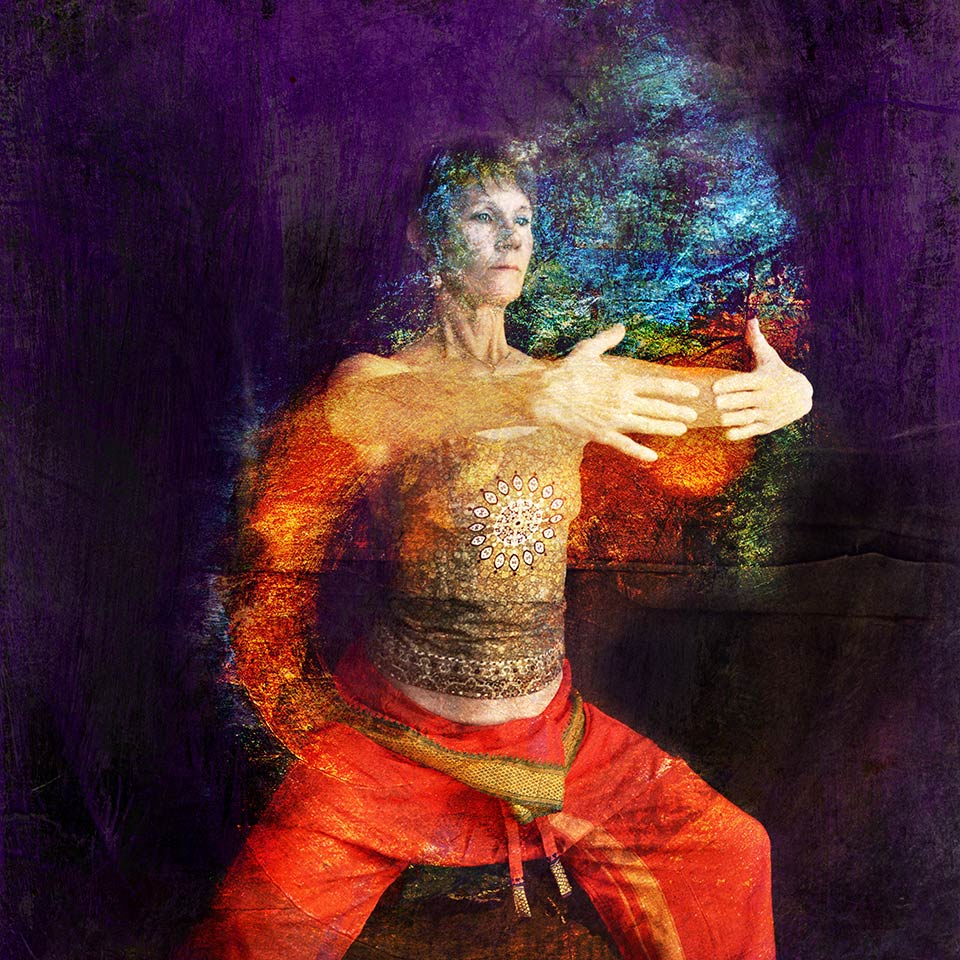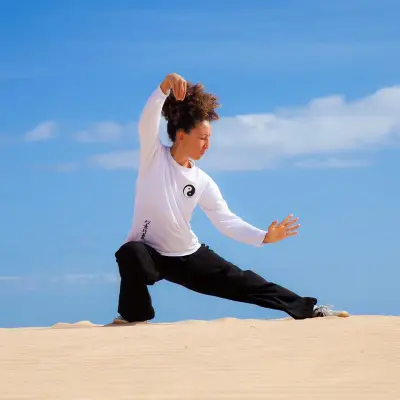Jump to:
The Essence of Qi Gong (Chi Gung)
Qi Gong (often spelled as “Chi Gung” and pronounced like “Chee Gung”) is an ancient Chinese practice that focuses on balancing one’s life energy, known as “Qi” or “Chi”. This energy is believed to flow through the body's meridians (the channels connecting acupuncture points), connecting all the organs and playing a key role in good physical and mental health. You can think of Qi Gong as a holistic practice that prioritises nurturing this life force.
In Qi Gong, individuals engage in a series of gentle, flowing movements, meditation, and controlled breathing techniques. These are designed to harmonise the mind, body and spirit, as well as ensuring smooth circulation of Qi throughout the body.
Origins & History
The origins of Qi Gong (Chi Gung) can be traced back over 5000 years to ancient China. The early practitioners of Qi Gong were Taoist monks and scholars who wanted to explore the connections between the natural world and the human body. Eventually, Qi Gong evolved and incorporated elements from other philosophical and medical systems, like Traditional Chinese Medicine (TCM).
Throughout Chinese history, Qi Gong was practised in both private and public settings. Some techniques were kept underwraps within specific families or lineages, while others were taught openly in martial arts schools, monasteries, and health centres. Because this practice is so versatile, it was accessible to people from all walks of life, and eventually its reach expanded beyond China.
Interestingly, Qi Gong also played a role in the development of traditional Chinese martial arts, such as Tai Chi and Kung Fu, by providing practitioners with better control over their physical and mental states.
Recommended for you!
Best SellersQi Gong Benefits
Practising Qi Gong can offer you many benefits and improve your general well-being in numerous ways. Here are some of the main benefits of Qi Gong (Chi Gung).
Relaxation & Reduced Stress
Qi Gong excels in helping individuals to relax and manage their stress - something that many of us could benefit from in this hasty and hurried life. It’s the slow, deliberate movements, combined with mindful breathing and meditation, that can envelop a person with a sense of calm and relaxation. As stress levels start to decrease, you’ll gradually start to experience better emotional stability and reduced anxiety, which will help you to get through those tough days in life.
Balance & Flexibility
The physical postures and movements you practise in Qi Gong encourage better balance, coordination, and flexibility. It’s so adaptable that it is beneficial for people of all ages, because it helps to maintain joint and muscle health. The gentle, flowing motions can also help to improve your posture and strengthen your core muscles, which contributes to improved stability and balance. The more you practise, the more flexible your body will become - everyday tasks will start to feel more manageable and your risk of muscle injury will reduce significantly.
Mental Focus
Practising Qi Gong involves a significant element of meditation and mindfulness. As a result, it sharpens mental acuity and concentration. As you practise regularly, being present in the moment will start to become second nature to you - you’ll be able to approach work and daily tasks with better focus and concentration.
Better Overall Health
As well as the above benefits, Qi Gong is known to improve one’s overall health, physically and mentally. It’s been linked to many physical health benefits like enhanced immune function, lowered blood pressure, and reduced inflammation. In some cases, it can aid in the management of chronic health conditions (when complemented with conventional medical treatments). In terms of emotional health, Qi Gong has been also used to alleviate symptoms of depression, anxiety, and even post-traumatic stress disorder (PTSD).

Qi Gong Techniques
Qi Gong (Chi Gung) is all about moving the body and connecting within to boost the flow of life energy (Qi) to improve your balance and general health.
Some of the key Qi Gong techniques are:
Static and Moving Postures
Qi Gong movements range from slow and flowing, to still and static poses. Each posture is carefully designed to open your energy channels so that Qi can pass freely through the body. The practice of static postures involves holding a particular position for a period of time, allowing the body to accumulate and circulate Qi within a specific area. On the other hand, moving postures that include graceful and coordinated movements attempt to facilitate the flow of Qi throughout the entire body.
Meditation and Visualisation
Meditation is a core component of Qi Gong. Within this practice, meditation normally involves focusing the mind on the breath, a specific energy centre (like the chakras) or a visual image. As you meditate, you’ll begin to release built up tension and start to feel more relaxed. You can also visualise the flow of Qi within the body and use your mind’s eye to direct and give power to the energy’s movement.
Healing Sounds and Vibrations
In Qi Gong, healing sounds are associated with specific organs and energy centres; they're intended to release stagnant Qi, clear any blockages, and rejuvenate the corresponding organ system. The sounds can be vocalised or created through particular movements and vibrations.
Here are some of the most common healing sounds used in Qi Gong:
- Xin - Heart sound (pronounced “sheen”) This sound is linked to the heart and can help to release tension in the chest area. It’s commonly used to help reduce stress and anxiety.
- Gan - Liver sound (pronounced “gahn”) Gan is connected to the liver and helps in detoxification. It ensures a smooth flow of Qi and can be quite beneficial to those who experience a lot of frustration or anger.
- Pi - Spleen sound (pronounced “pee”) The spleen sound is related to the spleen and stomach. Practising this healing sound is believed to support digestion and metabolism. It can also aid in reducing worry and overthinking.
- Fei - Lung sound (pronounced “fay”) This sound focuses on the lungs and helps to improve lung function and the respiratory system. It’s a good healing sound to practise for those who are experiencing grief or sadness.
- Shen - Kidney sound (pronounced “shuhn”) Shen is associated with the kidneys and can support the health of the kidney and bladder systems. It’s quite often used in Qi Gong to provide a boost of energy, while also addressing fears and insecurities.
- Sanjiao - The triple warmer sound (pronounced “sahn-jee-ow”) The triple warmer sound helps to balance the body's three "burner" areas. In Traditional Chinese Medicine (TCM), the “triple burner” refers to three regions in the body that are responsible for functions that are related to digestion, metabolism, and fluid distribution. The Sanjiao healing sound is also used to regulate the body’s temperature.
Qi Gong Vs Tai Chi
We briefly touched on Tai Chi and how Qi Gong actually played an important role in the development of this Chinese martial art. They do share a lot of similarities, since they both have roots in Traditional Chinese Medicine (TCM) and philosophy, so sometimes it is easy to confuse the two. However, they do have very distinct differences as well.
Qi Gong primarily focuses on balancing “Qi” - the body’s vital life energy - through exercises that include static and moving postures, breathing techniques and meditation. It’s practised mainly for its health benefits and can be used as a complementary therapy for multiple health conditions. Tai Chi is very similar in that it also incorporates slow flowing movements and postures with the goal to improve balance and coordination. However, the difference is that Tai Chi has more of a focus on self-defence, combined with meditation and well-being.
In terms of movements, Qi Gong involves a variety of movements. Some are gentle and flowing, while others are static. They can all be adapted to the person’s physical conditions and needs. The movements are also generally simple and are quite easy for beginners to learn. On the other hand, Tai Chi contains a specific sequence of continuous, flowing movements and forms, each with self defence applications, which makes it a martial art as well as mindfulness practice.
When it comes to choosing between the two, first consider what your goals are. If your main goal is to reduce stress levels and boost your energy, while having a range of exercises to choose from that are easy to learn for beginners and that are adaptable to various levels of fitness, then you might consider trying Qi Gong.
Inversely, if you’re more interested in the martial arts aspect of things and enjoy memorising specific sequences of movements that combine both physical exercise with mindfulness, then Tai Chi may be more suited to you.
Whether you begin on the path of Qi Gong or Tai Chi (or maybe both!) you’ll enter a journey of healing your body, physically and mentally. If you find that you resonate with Qi Gong, we offer an accredited Qi Gong (Chi Gung) diploma course for just £29 (save £118!), where you’ll be guided, in detail, on the various practices of meditation. Similarly, and for the same price, we offer an accredited Tai Chi Diploma course if you’d like to learn more about the benefits and philosophy behind this ancient martial art.













